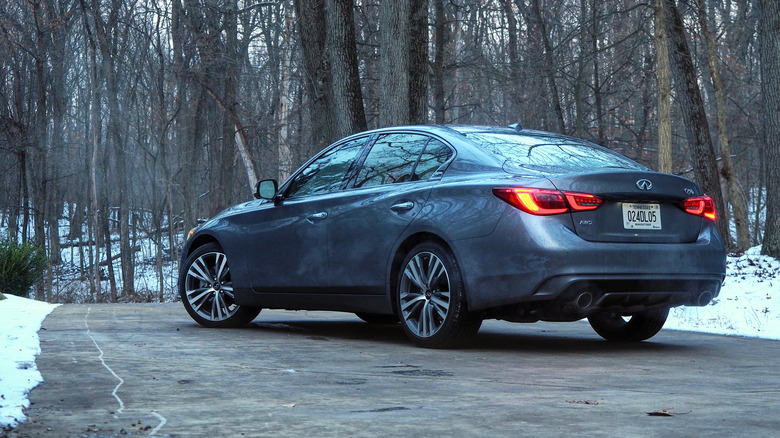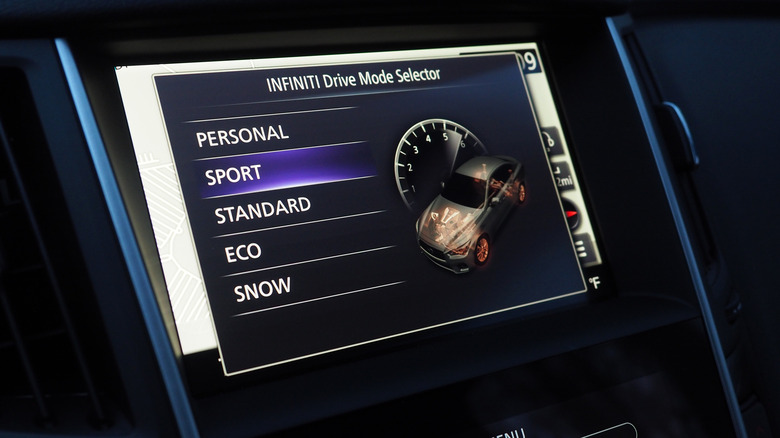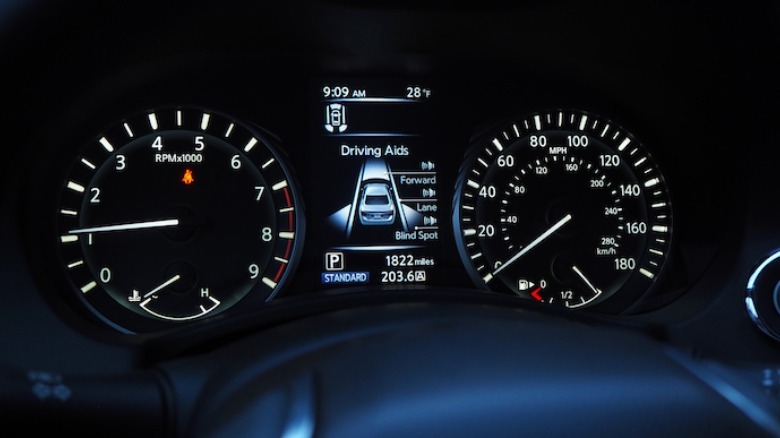2023 Infiniti Q50 Review: Aging Out
- Sleek styling still looks handsome
- V6 engine sounds great and has decent power
- 7-speed auto is a smooth-shifter
- Steering and suspension lack feel and confidence
- Infotainment and general tech feel old and tired
- Rival sedans offer more capability or cachet
I confess I'd forgotten about the Infiniti Q50. At a time when sedans continue to dwindle — in both sales and, arguably, relevance — in the U.S., you have to do something special in order to stand out. Problem is, Infiniti's message has struggled to achieve volume, and the Q50 has found it equally difficult to keep pace with its compact luxury competitors.
On the one hand, mainstays of the segment like the BMW 3 Series and Mercedes-Benz C-Class have badge cachet to go along with their capabilities. At the same time, relative upstarts like the Genesis G70 are bringing new, memorable alternatives to the category.
Infiniti, with more than three decades of brand recognition in the U.S. under its belt, not to mention the heft of Nissan to shape its engineering, should arguably be perfectly placed to straddle these two worlds. Yet as we've seen from the automaker before, a paucity of investment and an insistence on recycling old designs and old tech leave the Q50 at an instant disadvantage.
Last sedan standing
Infiniti's sole remaining sedan is a sleek, handsome thing. First launched in 2013, it owes its aesthetic to the Essence concept shown off at the Geneva International Motor Show in 2009. Wisely, the automaker opted not to mess too much with a good thing, and even after a refresh for the 2016 model year the design of the Q50 still stays relatively true to that curvaceous concept car.
The tweaks that have been made have generally kept pace with the trends of the sedan segment. The entry-level 2023 Q50 Luxe trim sticks with the glitter of chrome work on the exterior, dressing up the low-slung grille and glasshouse with some sparkle, but by the time you get to this Q50 Sensory trim, it's swapped for blacked-out detailing instead. Compared to the oversized snouts that many car designers are opting for, the Infiniti's nose looks positively restrained, though the illuminated badge may be a love-it-or-hate-it addition for the 2023 model year.
Sweeping lines make for a graceful car. It doesn't look especially big, but at almost 190 inches it's actually longer than a C-Class and a 3 Series. 18-inch wheels are standard on the Luxe trim, with 19-inchers on the Sensory and above.
One engine, two tunes
Long gone is Infiniti's hybrid engine, retired in favor of a pair of V6 options. The standard power plant is a 3.0-liter V6 tuned for 300 horsepower and 295 lb-ft of torque, courtesy of twin turbos. It's paired with a 7-speed automatic transmission, and rear-wheel drive is standard. All-wheel drive, biased to push all of the power to the rear wheels typically, but capable of a 50/50 split should traction demand it, is optional on all three trims — Luxe, Sensory, and the flagship Red Sport — for $2,000.
The Q50 Red Sport also gets a punchier tune of the V6, good for 400 horsepower. This may not be the newest engine on the block, but that doesn't mean it's a disappointment. In fact, Nissan has made excellent use of it — with a few tweaks, naturally — for its 2023 Z coupe. Of course, that starts at around $40k, while a Q50 Red Sport kicks off at more than $17k more than that.
With the standard engine, this $50,350 (plus $1,075 destination) Q50 Sensory AWD falls somewhere in the middle of the obvious competition. That budget isn't enough to get you into a new AMG C43 or BMW M340i, meaning you're playing with the 255 horses the Germans' respective 2.0-liter turbo-fours offer. Genesis, though, sweetens its G70 deal with the 3.3T AWD, starting at $46,750 (plus destination) in return for 365 horsepower.
Fun in a straight line, at least
I'd take the Genesis, but that's not because it's more powerful. The Q50 doesn't feel slow in a straight line, but while I've no complaints about grip, the overall feel in the corners doesn't match the G70's poise. The Infiniti's firm suspension gets just plain harsh and hard on anything but smooth asphalt, while the steering lacks the heft and the rapidity that Sport mode would lead you to expect.
The result is a car that's reasonably fun at acceleration — the engine sound is pleasing, compared to the over-processed notes that some sports cars now insist upon — but which doesn't really encourage you to tackle turns with any particular eagerness. In Comfort mode, the transmission slurs more smoothly and the wheel gets even lighter.
Only the Q50 Red Sport gets Infiniti's electronic suspension system with its adjustable dampers, which can tweak firmness depending on drive mode and road conditions. It's also the only trim that has paddle-shifters on the steering wheel, an odd omission given the Q50's positioning.
Cabin stumbles
We can almost certainly blame the Q50's age for that, and the same goes for the general levels of tech in the cabin. Infiniti's front seats are comfortable and supportive, and the $500 Premium Saddle Brown interior looks nice set against the matte-finish wood. All trims get a heated steering wheel, heated seats, dual-zone climate control, adaptive cruise control, a Bose 16-speaker audio system, wired Android Auto, and wireless Apple CarPlay.
That's a solid list, but the way it's all implemented feels old. Infiniti's dual-touchscreen InTouch infotainment system looks tired, and its UI is dated and confusing in places. While usually, I'll praise having physical controls for the essential features, the Q50's buttons for system navigation, HVAC, and multimedia are not only too numerous but aren't laid out intuitively.
Blind-spot warnings and intervention are standard across the board, as are forward emergency braking and lane departure warnings. The 13.5 cu-ft trunk is reasonable, but the cabin is low on storage spaces generally.
Stuck in a rut
As for economy, Infiniti says you can expect 19 mpg in the city from its all-wheel drive car, 27 mpg on the highway, and 22 mpg combined. I saw 21 mpg in my own, mixed driving. Unsurprisingly that falls somewhere in between the four-cylinder and six-cylinder versions of the Genesis G70, though the V6 version of the South Korean car is only a couple of points behind.
It's tough not to come to the conclusion that Infiniti is stuck in a rut, in many ways. The 2023 Q50 may illustrate the difficulties of an aging line-up and freshly-inspired rivals, but it's not like this is new territory. Perhaps most galling, in many cases it's sibling Nissan that is offering the most obvious competition: SUVs like the Armada and Pathfinder have raised their game so effectively, stepping up to the Infiniti equivalents just doesn't really make much sense.
For the Q50 specifically, the challenges are exacerbated by the state of the sedan market in particular. Even well-esteemed models are falling by the wayside — Kia Stinger, I'm pouring one out for you — and the blunt truth is that automakers need to do more if they're going to carve out a slice of a shrinking segment.
2023 Infiniti Q50 Verdict
Infiniti is clearly looking ahead. Its current SUVs are leagues better than the Q50, targeted refinements helping keep them feel far fresher, while electrification is on the roadmap. By 2030, the automaker says, the expectation is that the majority of Infiniti sales worldwide will be electrified, as part of Nissan Ambition 2030.
How that will look in practice is a black hole of information, however, and the only clear spot seems to be that the Q50 — at least as we know it — doesn't exactly feel like it has a place in that EV future. Though there's been no shortage of shapely concept sedans and coupes from the automaker's design studios over the past few years — teasing us with what an Infiniti electric car might look like — the actual transition will almost certainly be beginning with SUVs and crossovers (just as it has over at Nissan, with the Ariya).
That, though, is going to take a while before it arrives on the dealership forecourts. Today, the 2023 Q50 looks good but doesn't carry through with the driving dynamics, technology, or general glitter offered by its roster of rivals. A C-Class or 3 Series will earn you more approving nods in the parking lot or at the golf club, while a G70 will be more rewarding from behind the wheel.









